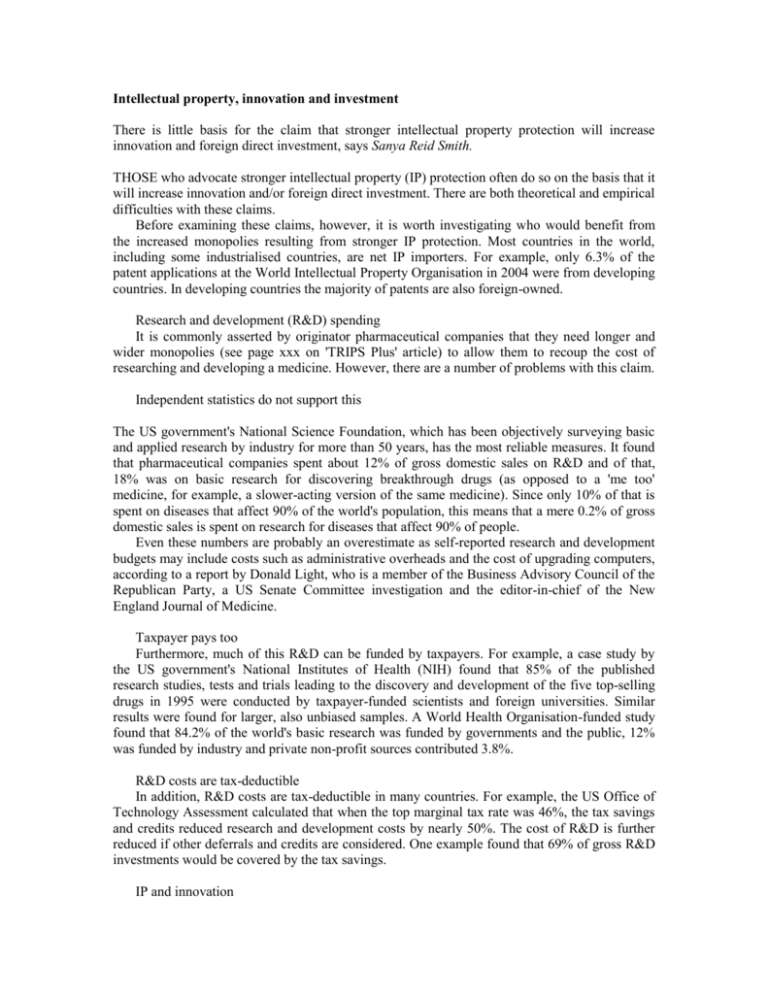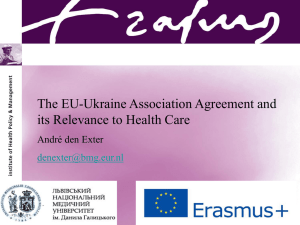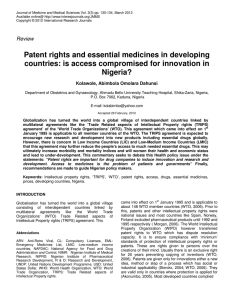Intellectual property, innovation and investment
advertisement

Intellectual property, innovation and investment
There is little basis for the claim that stronger intellectual property protection will increase
innovation and foreign direct investment, says Sanya Reid Smith.
THOSE who advocate stronger intellectual property (IP) protection often do so on the basis that it
will increase innovation and/or foreign direct investment. There are both theoretical and empirical
difficulties with these claims.
Before examining these claims, however, it is worth investigating who would benefit from
the increased monopolies resulting from stronger IP protection. Most countries in the world,
including some industrialised countries, are net IP importers. For example, only 6.3% of the
patent applications at the World Intellectual Property Organisation in 2004 were from developing
countries. In developing countries the majority of patents are also foreign-owned.
Research and development (R&D) spending
It is commonly asserted by originator pharmaceutical companies that they need longer and
wider monopolies (see page xxx on 'TRIPS Plus' article) to allow them to recoup the cost of
researching and developing a medicine. However, there are a number of problems with this claim.
Independent statistics do not support this
The US government's National Science Foundation, which has been objectively surveying basic
and applied research by industry for more than 50 years, has the most reliable measures. It found
that pharmaceutical companies spent about 12% of gross domestic sales on R&D and of that,
18% was on basic research for discovering breakthrough drugs (as opposed to a 'me too'
medicine, for example, a slower-acting version of the same medicine). Since only 10% of that is
spent on diseases that affect 90% of the world's population, this means that a mere 0.2% of gross
domestic sales is spent on research for diseases that affect 90% of people.
Even these numbers are probably an overestimate as self-reported research and development
budgets may include costs such as administrative overheads and the cost of upgrading computers,
according to a report by Donald Light, who is a member of the Business Advisory Council of the
Republican Party, a US Senate Committee investigation and the editor-in-chief of the New
England Journal of Medicine.
Taxpayer pays too
Furthermore, much of this R&D can be funded by taxpayers. For example, a case study by
the US government's National Institutes of Health (NIH) found that 85% of the published
research studies, tests and trials leading to the discovery and development of the five top-selling
drugs in 1995 were conducted by taxpayer-funded scientists and foreign universities. Similar
results were found for larger, also unbiased samples. A World Health Organisation-funded study
found that 84.2% of the world's basic research was funded by governments and the public, 12%
was funded by industry and private non-profit sources contributed 3.8%.
R&D costs are tax-deductible
In addition, R&D costs are tax-deductible in many countries. For example, the US Office of
Technology Assessment calculated that when the top marginal tax rate was 46%, the tax savings
and credits reduced research and development costs by nearly 50%. The cost of R&D is further
reduced if other deferrals and credits are considered. One example found that 69% of gross R&D
investments would be covered by the tax savings.
IP and innovation
It is commonly claimed by proponents of stronger IP protection that it will lead to increased
innovation. There are also some problems with this claim.
Some innovation is hampered by IP
In fact, studies have found that some innovation is hampered by intellectual property rights.
Firstly, stronger IP protection prevents the use of patented research tools needed for doing the
innovation and the eventual commercial production of any medicine developed. For example, a
US court fined Eli Lilly because its medicines infringed a patented biological pathway and so
Lilly has to pay US$65.2 million in back royalties and a future 2.3% royalty on sales of its two
medicines that use that pathway.
Secondly, science inventions in particular 'stand on the shoulders of those who have gone
before'. This process of incremental innovation is hampered by IP because although later
innovators could seek a voluntary licence from the patent holder, companies have admitted they
do not want to share their technology advantage with the competition, as India found when it
sought to develop more environmentally-friendly air-conditioners. (To obtain this voluntary
licence, the Indian company had to pay a licence fee 4-10 times higher than it should have been,
or had to agree to be taken over or to restrict its exports of the product. The deal fell through.)
These blocking patents mean that companies have to needlessly invent around the patented
product.
Stronger IP does not stimulate innovation
Many economists have found that stronger IP protection does not stimulate innovation and
this is supported by theory and empirical evidence. For example, when Italy and the European
Union as a whole strengthened their IP protection, their rate of innovation stayed constant or fell.
Similarly, issuing a compulsory licence is often characterised by patent holders as a reduction
in IP protection because it decreases the holder's monopoly. However academics have found that
issuing compulsory licences does not lead to a reduction of investment in R&D.
No incentives where there is market failure
Furthermore, many diseases are only suffered by people too poor to pay for any medicines,
for example tropical diseases which only affect developing countries ('neglected diseases'). As
there is no market incentive, regardless of the strength of the IP protection, no company will
develop a medicine. Stronger IP protection will not increase innovation for these diseases because
there is a market failure. This can be seen in the statistics: of 1,223 new drugs marketed
worldwide between 1975 and 1996, only 13 were developed to treat tropical diseases and only
four were the direct result of pharmaceutical industry research.
A number of other (non-IP protection) models have been proposed to solve this problem,
such as a prize fund which is already used by Eli Lilly to solve scientific problems.
Innovation occurs without IP protection
Experience shows us that there has been a lot of innovation when there was no IP protection.
For example, Switzerland made most of its famous discoveries during a period when it offered no
IP protection, free and open-source software is written without IP protection, and traditional
medicines in developing countries arose over thousands of years when there was no IP protection.
These traditional medicines include artemisin, the last remaining effective treatment for malaria
in many places.
Other factors prevent innovation
Whether R&D occurs in a particular country has been found to depend more on the human
capital available, facilities, tax incentives and many other factors, according to Azmi and Alavi's
survey of multinational pharmaceutical companies in Malaysia. For example, Malaysia has only
1/8th of the pharmacists per capita of the US and so does not have enough pharmacists to staff its
pharmacies, let alone do post-graduate study and invent new medicines.
IP and foreign direct investment (FDI)
Edwin Mansfield's widely cited study from 1994 claims that stronger IP protection will bring
increased FDI. However, Mansfield's study has been thoroughly criticised in an article by PJ
Heald. Some of these criticisms are listed below.
Mansfield's methodology was criticised because, among other things, the respondents were
self-selected and their claimed reasons for investment decisions were unverified. Mansfield's
study also did not distinguish between types of investment or types of IP protection. This is
problematic because usually developing countries want long-term FDI that involves establishing
factories in their country which employ local staff and produce goods which can also be exported
to earn foreign exchange. Ideally such a foreign investment would also transfer technology and
know-how to the local staff. Foreign 'investment' in the form of short-term capital flows or a oneperson office which imports finished products for consumption in the developing country does
not bring as much benefit.
When a foreign company is considering 'establishing a factory' in a developing country, to
avoid local staff learning its production methods and then setting up their own competing factory,
it needs strong trade secret laws which prevent employees from telling others the secret
production methods they learnt while being employed by the foreign company. Strong
employment laws are also preferred to enforce contracts in which local staff promise not to use
the trade secrets.
Moreover, countries with shorter patent periods and where less is patented should be
favoured by foreign investors choosing places to do manufacturing because fewer of their inputs
will be patented, so they will have to pay less in licence and royalty fees and can lower their
production costs. A clear example is that stronger IP protection would discourage FDI from
generic-medicine companies looking for places to site their manufacturing.
By contrast, if a foreign company is weighing up whether to set up a small office to import its
finished products (e.g. medicines) into the developing country, it will be most concerned about
trademark and copyright law. This is to ensure that local competitors cannot copy the investor's
trademark or packaging of the finished product.
Quotes from companies in Mansfield's study themselves support this analysis that trade secret
protection is more important to them than longer patent terms.
A 1993 United Nations study on IP and FDI found that there is insufficient linkage between
patents and FDI because cost, market size, levels of human capital and infrastructure
development and broad macroeconomic conditions were more important. This is borne out in
empirical evidence, for example in India as its levels of IP protection changed, and the Malaysian
survey of multinational pharmaceutical companies.
Conclusion
It is worth noting that Italy, Sweden and Switzerland did not allow patents on medicines until
1978 and Spain did not allow patents on chemicals or medicines until 1992 because it said it
could not afford the higher medicine prices as a result of patents.
Given the small markets in the majority of developing countries (compared to industrialised
countries), it would not significantly reduce the profitability of originator pharmaceutical
companies if they did not receive strong IP protection in developing countries. On the other hand,
such IP protection, which often goes beyond what is required under World Trade Organisation
rules, has a direct effect in making the prices of life-saving medicines very high.
Sanya Reid Smith is a researcher with the Third World Network.
Some references
PJ Heald, Information Economics and Policy 16 (2004) 57-65.
'TRIPS, Patents, Technology Transfer, Foreign Direct Investment and the Pharmaceutical
Industry in Malaysia', Ida Madieha Azmi and Rokiah Alavi, Journal of World Intellectual
Property, Vol 4 No. 6, November 2001.
'Rx R&D Myths: The Case Against The Drug Industry's R&D "Scare Card",' Public
Citizen, July 2001.
Monitoring Financial Flows for Health Research 2005: Behind the Global Numbers,
Global Forum for Health Research, page 31. The Global Forum for Health Research is funded by
the World Health Organisation, the World Bank, the Rockefeller Foundation and various national
governments. This chapter of the report was written by Donald Light, who, in addition to being
an academic, is a member of the Business Advisory Council of the Republican Party and a
member of the President's Business Commission.
Intellectual Property Rights and Economic Development - Historical Lessons and
Emerging Issues, Ha-Joon Chang, Intellectual Property Rights Series 3, Third World Network,
2001.





